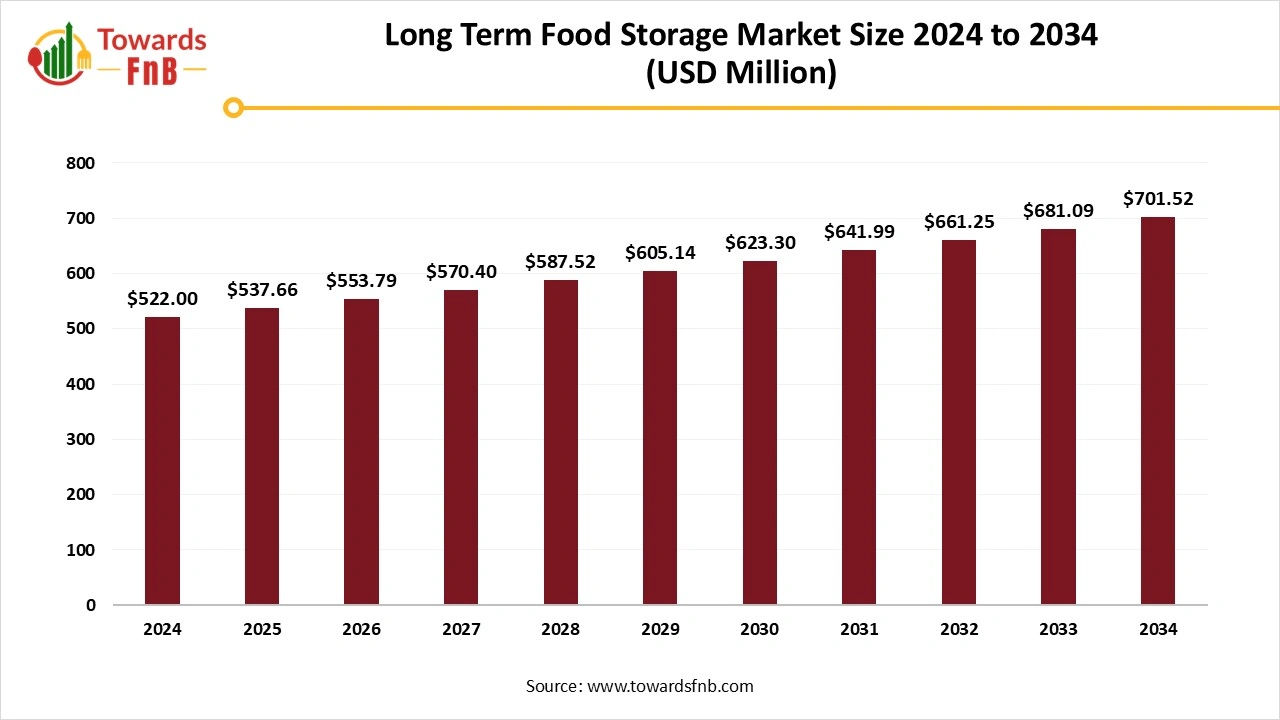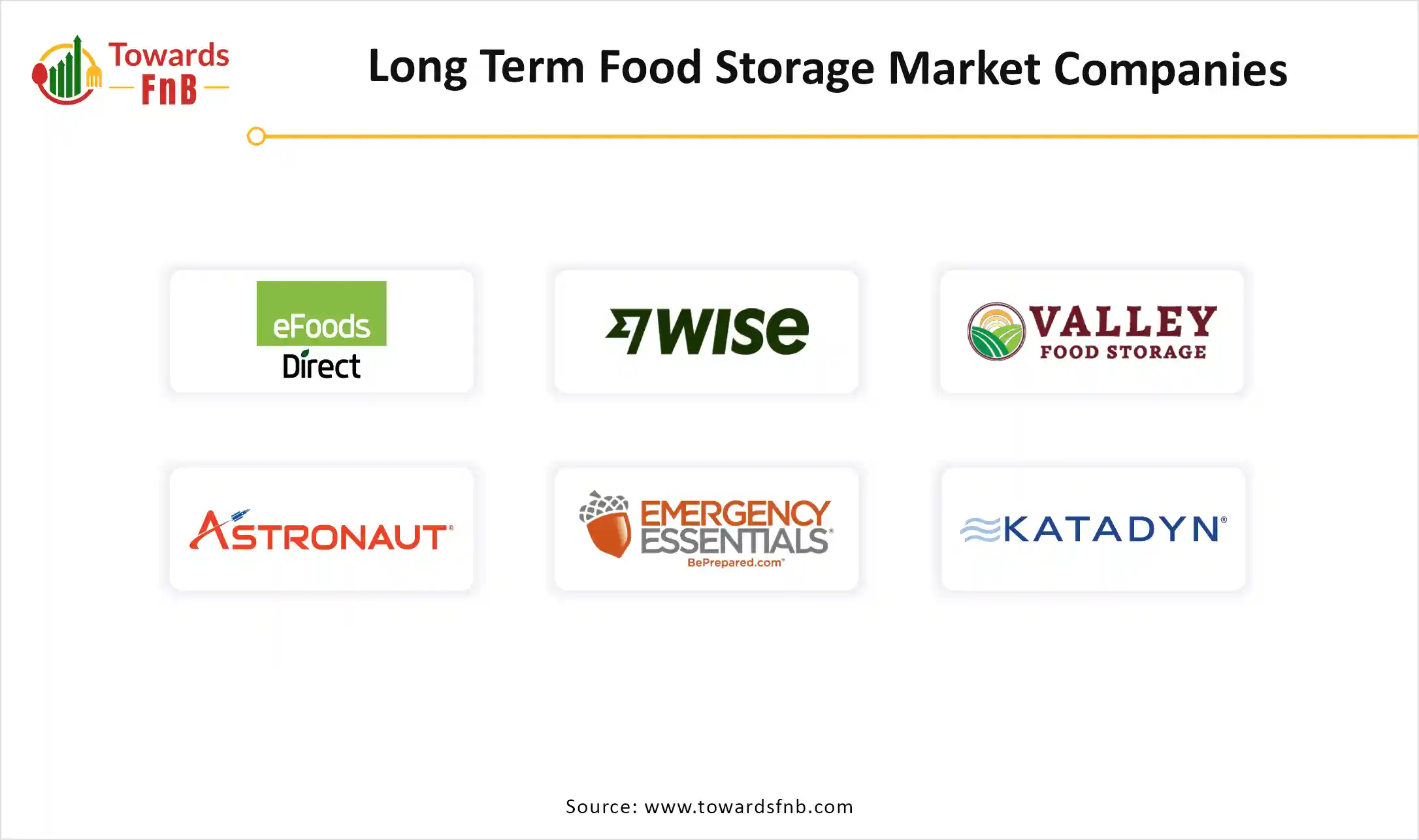October 2025
The global long term food storage market size reached at USD 522 million in 2024 and is anticipated to increase from USD 537.66 million in 2025 to an estimated USD 701.52 million by 2034, witnessing a CAGR of 3% during the forecast period from 2025 to 2034. Conditions like natural disasters, geopolitical tension, pandemic require food that can be stored for longer period, consumer demand for convenience and ready-to-eat meals and advanced packaging solution significantly driving the market.

| Study Coverage | Details |
| Growth Rate from 2025 to 2034 | CAGR of 3% |
| Market Size in 2025 | USD 537.66 Million |
| Market Size in 2026 | USD 553.79 Million |
| Market Size by 2034 | USD 701.52 Million |
| Largest Market | North America |
| Base Year | 2024 |
| Forecast Period | 2025 to 2034 |
| Regions Covered | North America, Europe, Asia-Pacific, Latin America, and Middle East & Africa |
The long term food storage market is increasingly vital in the context of global food security and preparedness. With the growing unpredictability of climate conditions, economic disruptions, and geopolitical tensions, consumers, businesses, and governments are focusing more on ensuring food availability in emergency situations. The importance of long-term food storage has surged due to the rise in natural disasters, pandemics, and supply chain disruptions, all of which underscore the need for reliable, long-lasting food supplies. By storing food that remains safe and nutritious over extended periods, this market addresses not only disaster preparedness but also contributes to global food sustainability.
Cutting-edge preservation methods are essential for ensuring the quality, safety, and nutritional integrity of food items, along with prolonging their freshness. These technologies include a variety of methods, such as electromagnetic, physical, and biological techniques, and are utilized throughout different phases of the food supply chain. Advancements in food preservation methods, including cold pasteurization, vacuum sealing, and smart storage solutions, are reshaping the food sector.
These technologies enhance the safety and quality of food while also encouraging more efficient and sustainable practices. As research and development progress, it is probable that new solutions will arise, improving how we store and savor food. Non-thermal technologies like pulsed light technology, cold plasma, pulsed electric fields, high-pressure processing, and ultraviolet radiation, in conjunction with natural preservatives and innovative packaging methods. Such technological innovations provide lucrative opportunities to manufacturer to provide extended life food products to meet consumer demand.
Degradation of nutritional value and sensory qualities is the critical challenge in the long term food storage market. extended storage can result in off-flavor. Vitamins like vitamin C, vitamin A and B- complex are sensitive to heat, oxygen and light. Storage of such food need proper infrastructure to maintain quality of food.
North America Led the Long Term Food Storage Market in 2024.
The long-term food storage sector in North America is a vibrant and varied industry that includes numerous products and services focused on maintaining, packaging, and distributing food items throughout the continent. North America serves as a center for manufacturing food storage items. Indigenous tribes in America employed techniques like smoking, drying, curing, and fermentation to keep foods like fish, meat, fruits, and vegetables for extended periods. These longstanding methods established the groundwork for subsequent advancements in food preservation.
The industrial revolution introduced important improvements in food preservation technology to North America. Convenience has emerged as a crucial element influencing the food storage market. Shoppers are looking for options that enable them to preserve food for extended durations without sacrificing quality and flavor. This requirement has resulted in the creation of cutting-edge storage solutions like modified atmosphere packaging, vacuum sealing, and intelligent storage of foods. As awareness of environmental sustainability grows and the economic effects of food waste become clearer, both consumers and businesses are looking for methods to reduce waste and boosting the long term food storage market.
The rising need for long-term food storage in the United States is fueled by a blend of factors, such as the pursuit of food security, readiness for possible emergencies, and an increasing focus on sustainable living. Moreover, the ease of having food ready for later use and less food waste are additional influencing factors. Multiple factors are shaping the direction of the long term food storage market. The demand for products that preserve freshness and extend shelf life is fueled by consumers' need for convenience and less food waste. The expanding e-commerce sector, especially in online grocery shopping, is increasing the demand for the food products with longer shelf life.
Asia Pacific Expects the Significant Growth in the Market During the Forecast Period.
The long term food storage market in the Asia-Pacific region is propelled by urban growth, rising disposable incomes, and changing consumer tastes for convenient, shelf-stable food choices. Increasing awareness of food storage and waste reduction has further fueled demand. The area's varied culinary offerings and increasing demand for ready-made meals among professionals. Worries regarding food scarcity and the effects of natural disasters have resulted in increased attention on food preservation and self-sufficiency.
increasing disposable incomes, urban growth, and the rise of nuclear families are creating a need for convenient and sanitary food storage options and boosts the long term food storage market of India. Busy lifestyles and the growing trend of online food delivery and meal kit services require portion control containers and leak-proof solutions for safe transportation. Regional governments are progressively allocating resources to strategic food reserves, cold chain logistics, and sustainable agricultural methods to enhance food security and reduce risks.
How Freeze-Dried Segment Dominated the Market In 2024?
Freeze-dried food segment dominated the long term food storage market with the largest share in 2024. Freeze dried food products provide fresh flavor and nutrients to emergency food storage, which is anticipated to foster sales in the period under consideration. The expansion of segment is boosted by the increasing popularity of hiking, camping, and other outdoor recreational activities and the rising utilization of freeze-dried food products by the emergency response organizations and military. Popularity of freeze-dried food is also rising among consumers who are seeking for convenient and healthy food options that can be conveniently prepared. With its extended shelf life, reserved nutritional value, and convenience, freeze-dried food is gaining popularity across diverse market sectors.
Canned Food Segment is Observed to Grow at the Fastest CAGR During the Forecast Period.
The rising preference for convenient and long-running food products is escalating the market growth. Consumer with hectic lifestyle, find canned food an attractive potion because of its effortless preparation and longer shelf life. Additionally, its significance in outdoor activities including camping and hiking, where availability refrigeration and cooking facilities may be constricted driving the demand for canned food. The rising worldwide participation in hiking and camping is anticipated to foster market growth during the projected timeframe.
What made Emergency Preparedness the Dominant Segment in 2024?
Emergency preparedness held the largest share of the long term food storage market in 2024. Emergency food items are created to be shelf-stable, simple to store, and fast to prepare, guaranteeing they can be easily distributed and eaten when conventional food supplies are interrupted. With increasing global uncertainties and climate-related disasters, the need for dependable emergency preparedness solutions is anticipated to rise. The evolution of this market is marked by advancements in packaging, nutritional value, and sustainable methods, showcasing continuous initiatives to improve food security and resilience amid global challenges.
Military Use Segment is Seen to Grow at a Notable Rate During the Predicted Timeframe.
This segment is boosted by the increase in military operations, modernization of military forces, and an increasing focus on offering high-standard nutrition and convenience to soldiers need long term food storage. Extended shelf-life food products such as ready to consume foods are compact, self-contained meals developed to provide balanced nutrition with a longer shelf life, making them perfect choice for locating in combat zones, training exercises, and other remote or demanding areas. The rising demand for portable, lightweight, and nutrient-dense food solutions that cater the dietary requirements of troops in the field is an important factor boosting the market.
Why did the Direct Sales Segment Dominate in 2024?
Direct sales led the long term food storage market in 2024. The growth is primarily attributed to increasing demand from customers to check and validate a product before buying. Consumers can validate and check quality of various food products. direct selling offer variety of frozen, dehydrated and canned products with extended shelf life. New business models have evolved as a result of the digital ecosystem and shifting consumer requirements, leading to the rise of direct-to-consumer distribution channels.
Online Channel Segment is Expected to Grow at the Fastest CAGR in the Long Term Food Storage Market During the Forecast Period.
Shift in the buying habits of customers have prominently accelerated the growth of e-commerce. Due to unavailability of time, demand for a smooth shopping process, and the convenience of online purchasing, customers majorly choose the digital marketplace. With the rising utilization of smartphones and tablets, mobile technology especially has been essential in allowing customers to buy seamlessly from wherever they want.
Army Combat Capabilities Development Command's Soldier Center's
SATS
Samsung

By Type
By Application
By Distribution Channel
By Region
October 2025
October 2025
October 2025
October 2025